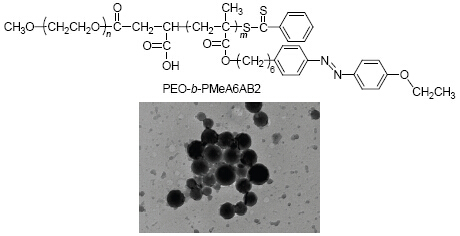Search
Title: Synthesis and Self-assembly Behavior of Photo-responsive Diblock Copolymers with Different Hydrophilic/Hydrophobic Ratios
Author: Yanchun Ding, Yanlei Yu, Jia Wei*
Journal: Acta Chim. Sinica, 2014, 72(5), 602-608
Abstract:
A series of diblock copolymers, poly(ethylene oxide)-block-poly{6-[4-(4-ethoxyphenylazo) phenoxy] hexyl methacrylate} (PEO-b-PMA6AB2), with different hydrophilic/hydrophobic ratios were synthesized by reversible addition-fragmentation chain transfer (RAFT) polymerization. The structures and properties of diblock copolymers were characterized by 1H NMR and gel permeation chromatography (GPC). The self-assembly method was as follows: block copolymers were dissolved in tetrahydrofuran (THF) at first, and then by adding water at the rate of 2.5 μL/s, the aggregates self-assembled when the critical micelle concentration (CMC) was reached. Field emission transmission electron microscope (FETEM), scanning electron microscope (SEM), field emission scanning electron microscope (FESEM), optical microscope, particle size analyzer, UV-Vis absorption spectroscope and fluorescence emission spectroscope were used to study the morphology and size of the aggregates and their stimuli-responsive behavior. The SEM and FETEM results showed that polymeric micelles and large compound micelles (LCM) coexisted in the aqueous solution. Furthermore, it was found that the size of the self-assembly reduced with the decrease of initial concentration and the increase of stirring rate, and the distribution tended to be uniform. Meanwhile, the morphology of large compound micelles turned to be different, changing from common sphere to peanut shape or rod-like shape when the hydrophilic/hydrophobic ratio was 2.3. By encapsulating Nile Red into the aggregates, the peanut shape and rod-like shape were captured by fluorescence microscope. UV-Vis absorption spectra of the self-assembly revealed that the photo-responsive behavior of azobenzene moieties in the aggregates was reversible but restricted to some extent. The change on fluorescence intensity of Nile Red encapsulated in the diblock copolymer aggregates indicated that the alternative irradiation of UV and visible light induced the release of Nile Red resulted from the photoisomerization of the azobenzene moieties. In addition, the photo-responsive study showed that large compound micelles self-assembled from BCP-S3-0.82 could dissociate under the irradiation of UV light. Other large compound micelles assembled from the rest of block copolymers also dissociated, but the extent of the dissociation was not as remarkable as BCP-S3-0.82, which had the maximal hydrophobic ratio.
Fulltext Link: http://sioc-journal.cn/Jwk_hxxb/CN/10.6023/A14010069








